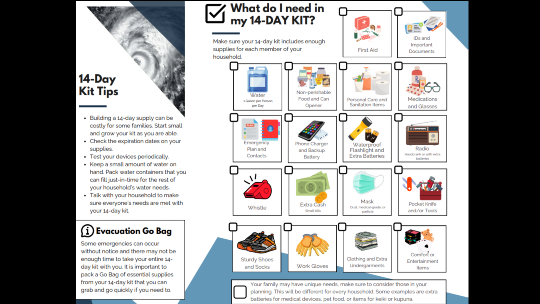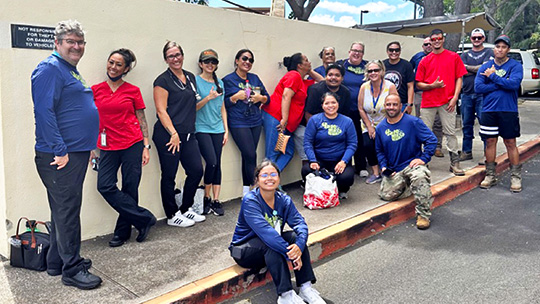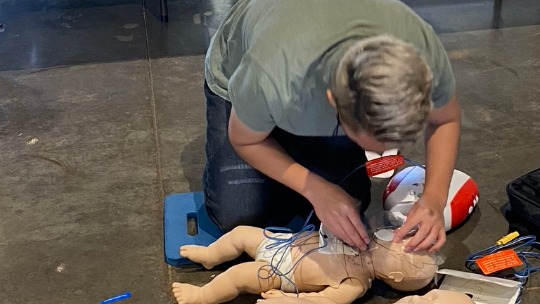It’s peak hurricane season. Are you prepared?
Honolulu’s Department of Emergency Management recommends building a disaster supply kit with enough food and water for at least 14 days. Since we live on an island, we don’t have the option of driving somewhere that hasn’t been impacted by a hurricane or another disaster. Having a 14-day supply for each member of your household is essential, just in case our ports close and can’t accept shipments.
So, what should you include?
- IDs and important documents
- Phone chargers
- Radio
- First aid supplies
- Personal care and sanitation items
- Medications and glasses
- Whistle
- Waterproof flashlight and extra batteries
- Extra cash
- Clothing, sturdy shoes, and socks

List on Honolulu's Dept. of Emergency Management website.
And, of course, one gallon of water per gallon per day, as well as non-perishable food and a can opener. Here’s a list of healthier, non-perishable options that we have stored in our 14-day kits.
Canned tuna is a protein-packed option that can be mixed with olive oil and capers and spread over crackers or whole wheat bread.
Organic lentil soup often has ingredients such as lentils, carrots, onions, potatoes, olive oil, sea salt, and bay leaves.
Almond butter can be eaten straight out of the jar or paired with crackers or fruit.
Pre-packaged quinoa bowls are a good source of fiber and protein.
Single-serving pouches are a great way to upgrade your canned goods. Try premium olives, chicken, or tuna.
White miso soup can be made by mixing instant soup mix with hot water. The soup packets usually contain garnishes such as mushrooms and tofu, but you can also enhance your soup by adding more of your own.
Black beans are versatile and can be served as a hearty side dish or included in a salad or stew.
Local snacks like wasabi peas and dried shrimp are a little high in sodium but contain less fat than potato chips or beef jerky.
Want to prepare a simple dinner during a storm? Island Scene writer Craig DeSilva shares his no-mayo tuna pita recipe.
Ingredients
- 2 Tbsp. lemon juice
- 2 Tbsp. olive oil
- 2 5-oz. cans of tuna packed in water, drained
- ½ small red onion, diced
- ½ cup grape tomatoes, halved
- ½ cup pitted kalamata olives, halved
- 2 large whole wheat pitas
Instructions
In a large bowl, combine lemon juice and olive oil. Add the tuna, red onion, tomatoes, and olives and gently toss. Carefully open the pitas and fill with the tuna salad mixture. Makes 2 servings.
This article was originally published in 2015. It has been updated with new hurricane preparedness guidance from the Honolulu Department of Emergency Management.
Natural disaster recovery
From wildfires to hurricanes to tsunamis, our Islands have experienced all kinds of devastating natural disasters. The stories of recovery that emerged from these tragic events are nothing short of heroic:
health care heroes of the lahaina wildfires
When disaster strikes, there are those who rush to the aid of others. Here are stories of three health care heroes who mobilized their teams, gathered resources, and saved countless lives during the August 2023 wildfires.

surviving a tsunami
In May 1960, after an 8.3-magnitude earthquake struck Chile, tsunami warning sirens sounded in Hawaii. But then, the warning was canceled. Hours later, people in Hilo woke up to deafening screams as a 35-foot wave struck the area. Read this harrowing account of how the writer’s mother survived the disaster on May 23, 1960.
volunteering with the american red cross
Wherever there are people in need, the American Red Cross is there. This nonprofit humanitarian organization has been providing disaster relief, emergency assistance, and disaster preparedness education since its establishment in 1881. And they couldn’t do it without their volunteers! Two local volunteers share what kind of work they’ve done, why they do it, and how you can help, too.





